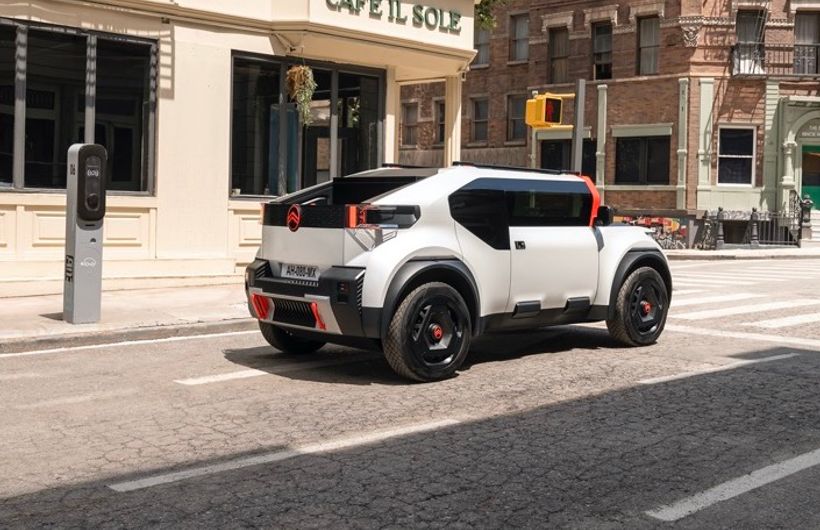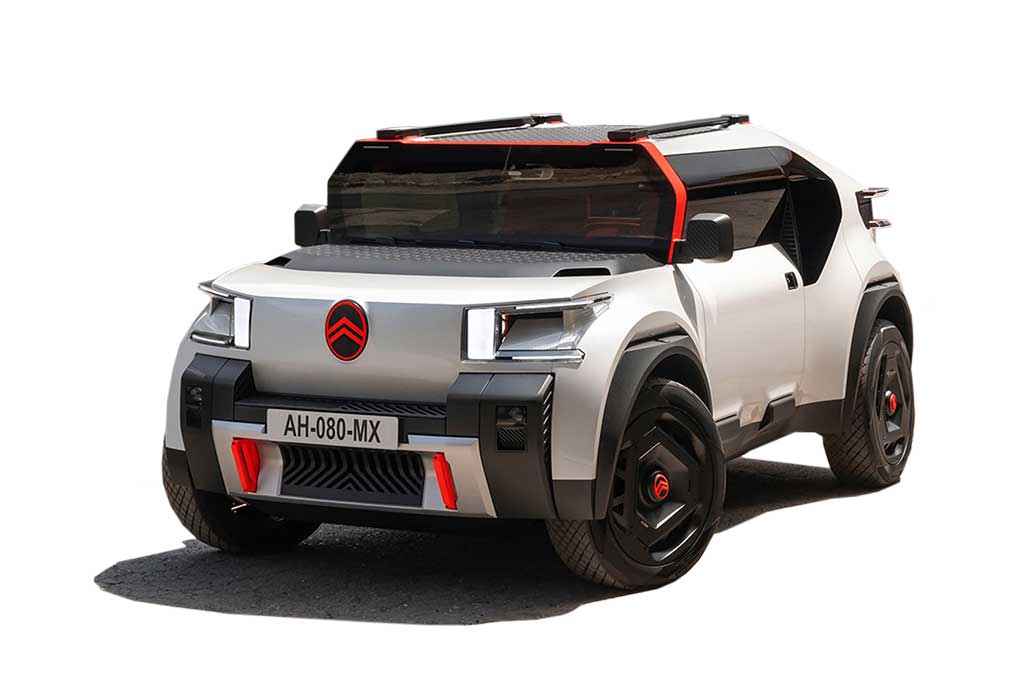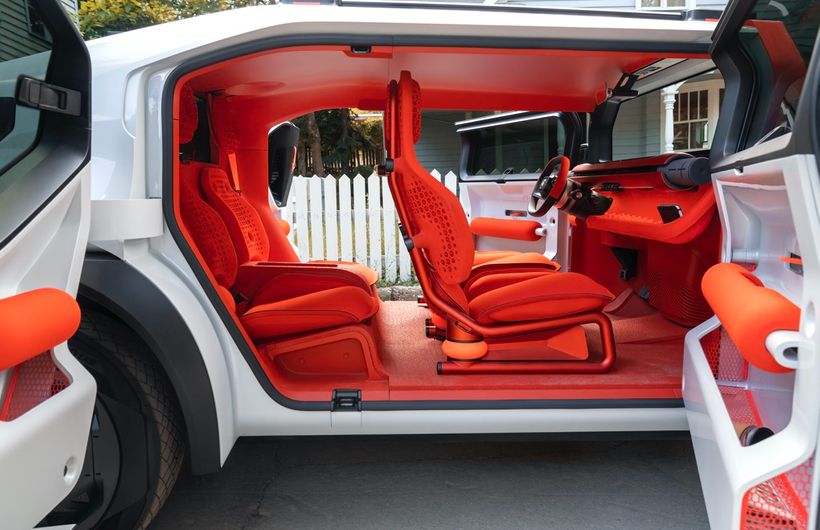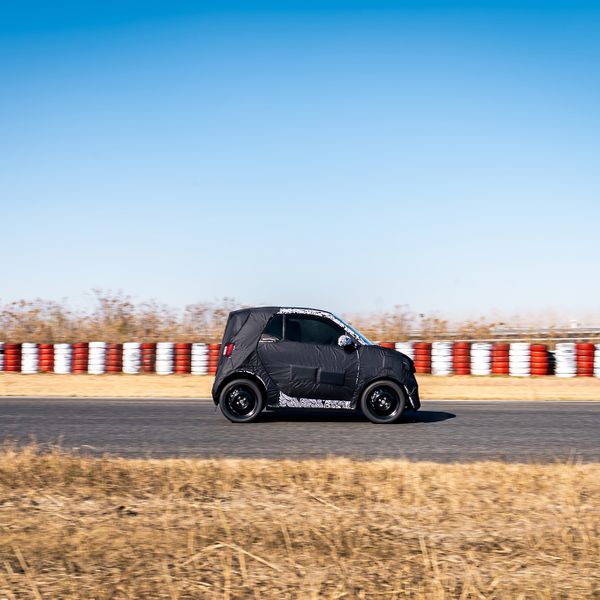Love the Citroen Ami but need something a bit bigger – and faster? Citroën is doubling down on its radical designs for electric cars with a concept which points the way to a new family sized electric car with radical features – including mesh seats and cardboard panels - to make it lighter, more efficient and more affordable.
The Oli is described as a ‘laboratory on wheels’ which aims to buck industry trends for heavier, more complex and expensive electric cars.
Rather than being filled with screens and gadgets, the Oli provides just what Citroën thinks customers need and want, supported by the inventive use of responsible materials and a sustainable production process. Its target vehicle weight of around 1,000kg makes it significantly lighter than most comparable compact SUVs, even those with petrol power.
Watch Ginny's video review of the Oli here.
![]() The Oli weighs less that a petrol city car
The Oli weighs less that a petrol city car As a result, the Oli’s all-electric powertrain needs only a 40kWh battery to deliver a target range of up to 250 miles. The top speed is limited to just below the legal motorway limit in the UK to maximise efficiency, and recharging from 20% to 80% takes 23 minutes.
The weight loss programme has been possible by rethinking components. The seats, for example, are simply constructed and use 80% less parts than a traditional seat. They are made of recycled materials and ‘mesh’ backrest designs enhance the natural light inside the vehicle. They can also be easily upgraded or personalised to suit the taste of individual owners.
Its flat bonnet, roof and rear load bed panels are made from recycled corrugated cardboard formed into a honeycomb sandwich structure between fibreglass reinforcing panels. To stop them dissolving in the rain, they are covered in polyurethane resin and a special paint which is often used on or loading ramps.
![]() The bonnet, rood and load panels are made of cardboard coated in resin
The bonnet, rood and load panels are made of cardboard coated in resin The panels are very rigid, light and strong – so strong that an adult can stand on them – and weight is reduced by 50 percent when compared to an equivalent steel roof construction.
The windscreen is vertical because it’s the shortest distance between top and bottom and uses the smallest amount of glass. As well as reducing weight and complexity, the smaller screen is less expensive to produce or replace and lessens the exposure of occupants to the effects of the sun. It is also estimated to help reduce the power demand Oli’s air conditioning by up to 17%.
To make it more aerodynamic, the Oli features an experimental “Aero Duct” system between the front section of the bonnet and the flat top panel which blows air towards the screen, creating a curtain effect to smooth air flow over the roof.
![]() The vertical windscreen keeps costs down and the interior shaded, reducing the need for air con
The vertical windscreen keeps costs down and the interior shaded, reducing the need for air con The side windows are also tilted slightly towards the ground to help to reduce the effects of the sun, and manual, “flip up” opening sections, similar to those used on Ami and classic 2CV, provide ventilation. The front doors follow the example set by Ami and are identical on each side, though mounted differently. They are lighter, yet still strong, and much easier to make and assemble.
Reducing complexity and simplifying construction saves 20% in weight per door compared to a typical family hatchback. Half the number of components is required, and around 7kg per door is saved by the removal of the loudspeaker, soundproofing material, and electrical wiring.
Instead of a full dashboard with multiple screens and computers, the Oli features a single symmetrical beam running across the width of the vehicle, again similar to the original 2CV. It has a smart phone dock, and five toggle switches for the air conditioning system in the centre.
![]() The central beam has just the basic controls - all of the infotainment is via your smartphone
The central beam has just the basic controls - all of the infotainment is via your smartphone The beam houses an electrified rail into which accessories can be plugged via USB sockets. All the infotainment and communication is via your personal smartphone, as Citroen realise that it is more powerful than any car’s computing power and is kept up to date constantly. Each end of the beam is hollow and cylindrical Bluetooth loudspeakers can be ‘docked’ to provide high-quality sound.
The narrower rear doors are hinged at the rear of the vehicle and use vertical glass to give rear passengers more light and visibility. The floor is also covered with a highly elastic and waterproof coating and can be easily hosed clean.
Round at the boot, the Oli has another party trick, as it can become a pick up truck. The rear seat headrests pop up into the roof, the rear screen glass opens upwards, and the load bed expands in length from 679mm to 1050mm.
The tailgate folds down and with the load bed panel removed, there is up to 582 mm height between the vehicle floor and the rear glass. The removable bed panel is light and flat, and made from the same recycled cardboard structure as the bonnet and roof panels.
![Citroen Oli concept, high rear and side shot, being loaded with boot open]() The Oli's boot can quickly convert to become a pick up
The Oli's boot can quickly convert to become a pick up Even the wheels are lightweight. Because full aluminium wheels are expensive and energy intensive to produce and full steel rims are heavy, the decision was taken to blend the two. The resulting hybrid wheels are 15 per cent lighter than the equivalent full steel wheel, contributing an overall vehicle weight reduction of 6kg.
They are wrapped in Goodyear tyres which are designed to have last more than 300,000 miles, as the 11 mm tread depth can be renewed twice across the lifetime of the tyre.
This is part of a strategy for the car which maximises longevity and durability so, like a house, it can have multiple owners and a longer active life cycle. It will be easy to repair, refurbish, upgrade and personalise so it can easily be passed on ‘as new’ to several successive owners, or kept in a family for younger generations to enjoy
![]() The wheels are 6kg lighter and wear tyres that can last 300,000 miles
The wheels are 6kg lighter and wear tyres that can last 300,000 miles Citroën CEO, Vincent Cobée explains why he thinks time is right for the Oli: “A typical mid-70s family car weighed around 800kg and was 3.7 m long and 1.6m wide. Today’s equivalents have grown to more than 1,200kg, at least 4.3 m long and 1.8m wide. Some even weigh more than 2,500kg.
“We need to reverse the trends by making them lighter and less expensive and find inventive ways to maximise usage and refurbish for subsequent owners. Otherwise, families won’t be able to afford the freedom of mobility when all-electric vehicles become the only option available to them. Oli is a powerful demonstration of how Citroën is confronting these conflicts head-on and with optimism.”
![]() The doors open to give wide access to the interior, like a BMW i3
The doors open to give wide access to the interior, like a BMW i3  The Oli weighs less that a petrol city car
The Oli weighs less that a petrol city car 


















